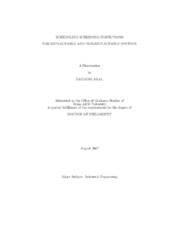| dc.description.abstract | This dissertation focuses on developing inspection schedules to detect non-self-
announcing events which can only detected by inspections. Failures of protective sys-
tems ,such as electronic equipments, alarms and stand-by systems, incipient failures
and the emergence of certain medical diseases are examples of such events. Inspec-
tions are performed at pre-determined times to detect whether or not the event has
occurred, and necessary actions are taken upon the detection. In this research, my
interest is in developing effective inspection schedules to detect non-self-announcing
events that balance system downtime and inspection effort.
To evaluate the quality of an inspection schedule, I use the availability (for re-
placeable) and the detection delay (for non-replaceable systems) as performance mea-
sures. When the monetary cost of inspection and the cost of delay are difficult to
determine, non-monetary performance measures become more meaningful. In this
research, the focus is on maximizing availability or minimizing detection delay given
a limited number of inspections or a limited inspection rate. I show that for replace-
able and non-replaceable systems, it is possible to construct inspection schedules that
perform better than periodic inspection with respect to our performance measures.
The occurrence of the event I would like to detect may be influenced by certain
individual characteristics. For instance, the risk of developing a certain type of dis-
ease might be different for different subgroups within the population. In this case, because of the non-homogeneity in the population, benefits of performing screening
tests may not be fully achieved for each sub-group by using an inspection strategy
developed for the entire population. Thus, it may be of value for an individual to
learn more information about his/her likehood to have the disease. To address this
issue, I analyze the change in the expected delay if schedules are based on the whole
population information or the individual information and provide numerical results. | en |


